Sex Crime and Justice Assignment: Online Sexual Harassment Analysis
VerifiedAdded on 2020/04/21
|10
|2609
|74
Essay
AI Summary
This essay delves into the multifaceted issue of online sexual harassment, examining its various forms, impacts, and the role of technology in its proliferation. The essay begins by defining sexual harassment and highlighting its prevalence in the digital age, drawing upon a case study published in CNN to illustrate the devastating consequences for victims. It explores the evolution of online harassment, referencing incidents like the #MeToo movement and statistics from the Pew Research Center to emphasize the gendered nature of the problem. The essay provides a critical evaluation of the issue, discussing cyberbullying, sexual exploitation, and the rise of revenge pornography. It also addresses the biases in online sexual harassment based on gender and sexuality, and the role of mobile technology in facilitating such acts. The essay concludes by emphasizing the increased vulnerability of heterosexual women and the lasting impact of online harassment, underscoring the need for greater awareness and legal protections in the face of technological advancements. The essay draws upon various sources including news articles and research papers to support its arguments.
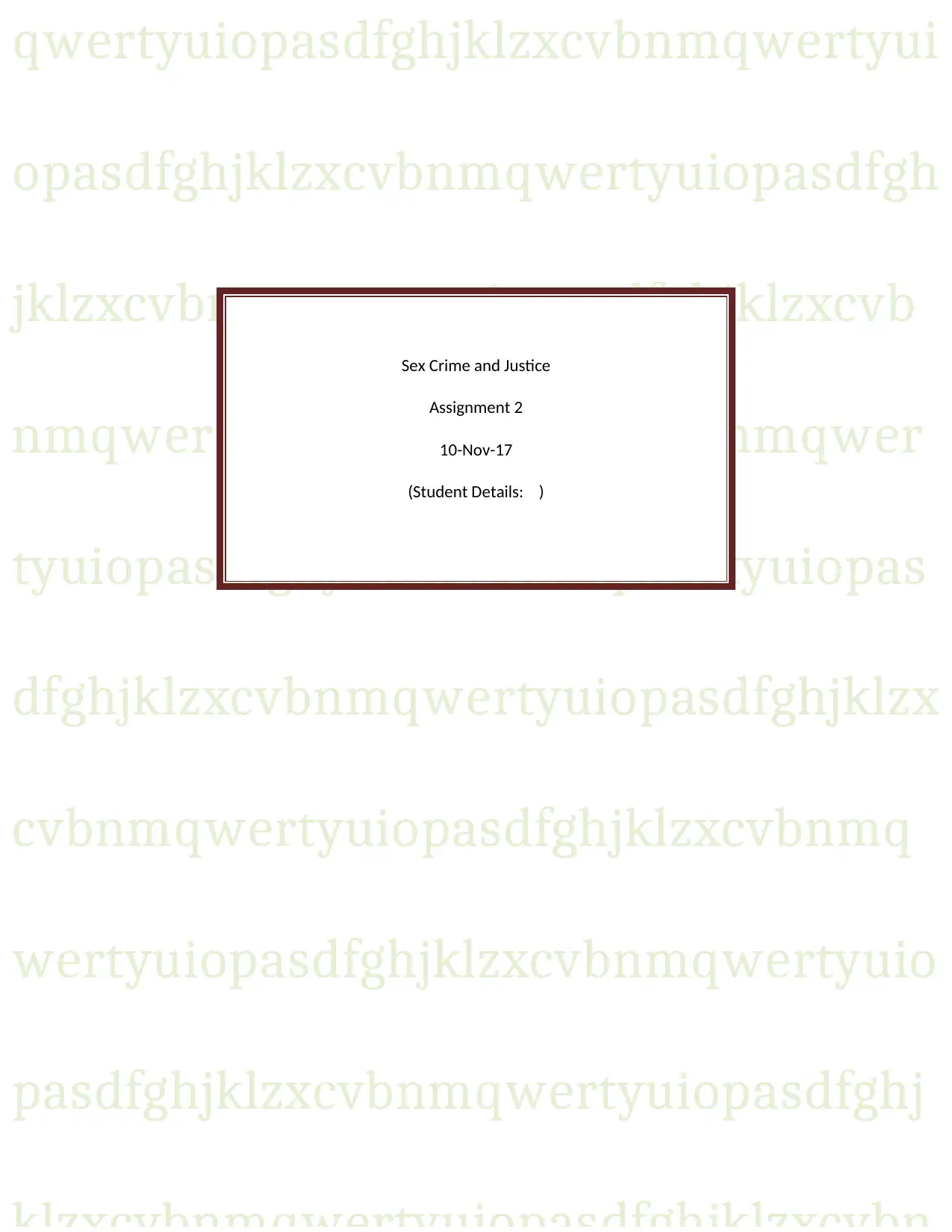
qwertyuiopasdfghjklzxcvbnmqwertyui
opasdfghjklzxcvbnmqwertyuiopasdfgh
jklzxcvbnmqwertyuiopasdfghjklzxcvb
nmqwertyuiopasdfghjklzxcvbnmqwer
tyuiopasdfghjklzxcvbnmqwertyuiopas
dfghjklzxcvbnmqwertyuiopasdfghjklzx
cvbnmqwertyuiopasdfghjklzxcvbnmq
wertyuiopasdfghjklzxcvbnmqwertyuio
pasdfghjklzxcvbnmqwertyuiopasdfghj
Sex Crime and Justice
Assignment 2
10-Nov-17
(Student Details: )
opasdfghjklzxcvbnmqwertyuiopasdfgh
jklzxcvbnmqwertyuiopasdfghjklzxcvb
nmqwertyuiopasdfghjklzxcvbnmqwer
tyuiopasdfghjklzxcvbnmqwertyuiopas
dfghjklzxcvbnmqwertyuiopasdfghjklzx
cvbnmqwertyuiopasdfghjklzxcvbnmq
wertyuiopasdfghjklzxcvbnmqwertyuio
pasdfghjklzxcvbnmqwertyuiopasdfghj
Sex Crime and Justice
Assignment 2
10-Nov-17
(Student Details: )
Paraphrase This Document
Need a fresh take? Get an instant paraphrase of this document with our AI Paraphraser
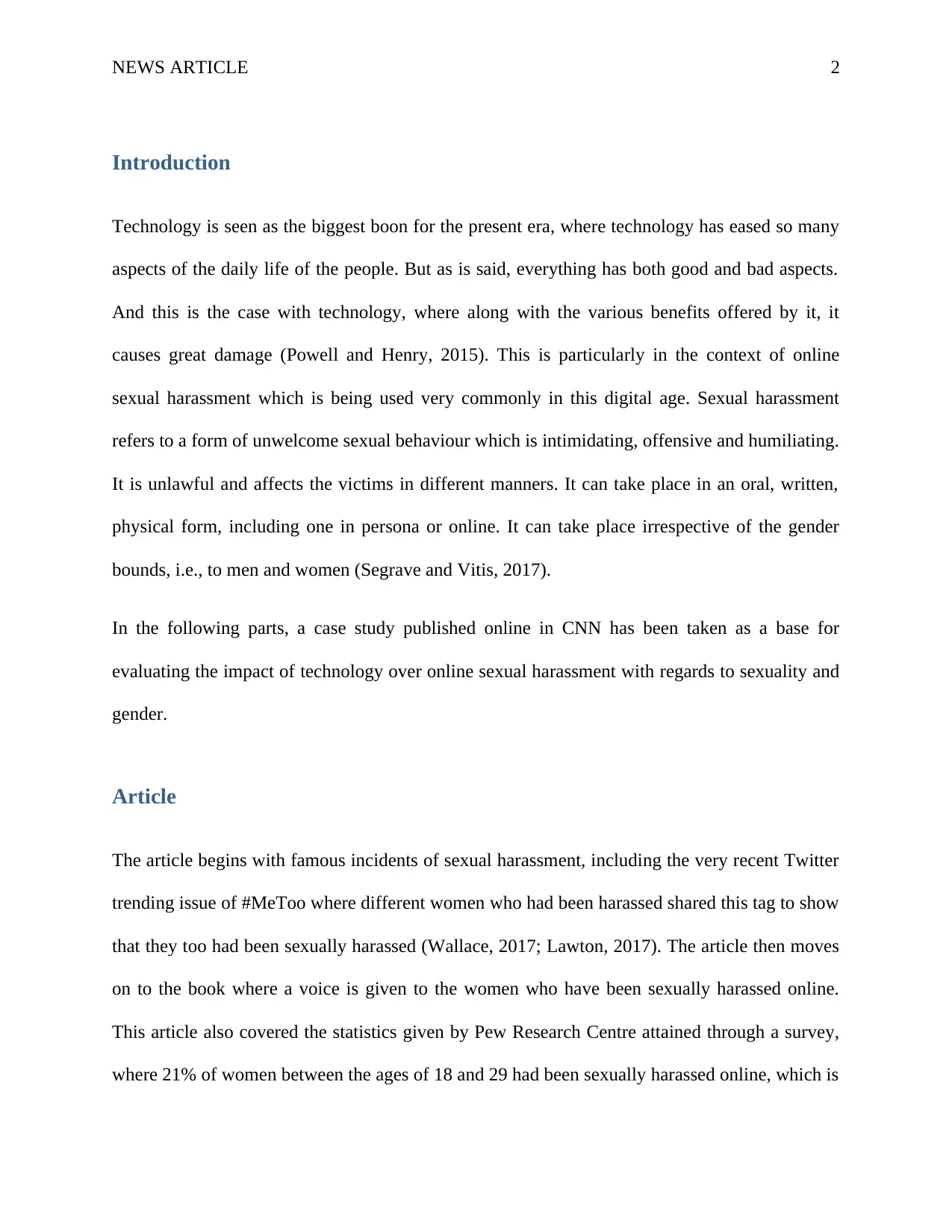
NEWS ARTICLE 2
Introduction
Technology is seen as the biggest boon for the present era, where technology has eased so many
aspects of the daily life of the people. But as is said, everything has both good and bad aspects.
And this is the case with technology, where along with the various benefits offered by it, it
causes great damage (Powell and Henry, 2015). This is particularly in the context of online
sexual harassment which is being used very commonly in this digital age. Sexual harassment
refers to a form of unwelcome sexual behaviour which is intimidating, offensive and humiliating.
It is unlawful and affects the victims in different manners. It can take place in an oral, written,
physical form, including one in persona or online. It can take place irrespective of the gender
bounds, i.e., to men and women (Segrave and Vitis, 2017).
In the following parts, a case study published online in CNN has been taken as a base for
evaluating the impact of technology over online sexual harassment with regards to sexuality and
gender.
Article
The article begins with famous incidents of sexual harassment, including the very recent Twitter
trending issue of #MeToo where different women who had been harassed shared this tag to show
that they too had been sexually harassed (Wallace, 2017; Lawton, 2017). The article then moves
on to the book where a voice is given to the women who have been sexually harassed online.
This article also covered the statistics given by Pew Research Centre attained through a survey,
where 21% of women between the ages of 18 and 29 had been sexually harassed online, which is
Introduction
Technology is seen as the biggest boon for the present era, where technology has eased so many
aspects of the daily life of the people. But as is said, everything has both good and bad aspects.
And this is the case with technology, where along with the various benefits offered by it, it
causes great damage (Powell and Henry, 2015). This is particularly in the context of online
sexual harassment which is being used very commonly in this digital age. Sexual harassment
refers to a form of unwelcome sexual behaviour which is intimidating, offensive and humiliating.
It is unlawful and affects the victims in different manners. It can take place in an oral, written,
physical form, including one in persona or online. It can take place irrespective of the gender
bounds, i.e., to men and women (Segrave and Vitis, 2017).
In the following parts, a case study published online in CNN has been taken as a base for
evaluating the impact of technology over online sexual harassment with regards to sexuality and
gender.
Article
The article begins with famous incidents of sexual harassment, including the very recent Twitter
trending issue of #MeToo where different women who had been harassed shared this tag to show
that they too had been sexually harassed (Wallace, 2017; Lawton, 2017). The article then moves
on to the book where a voice is given to the women who have been sexually harassed online.
This article also covered the statistics given by Pew Research Centre attained through a survey,
where 21% of women between the ages of 18 and 29 had been sexually harassed online, which is

NEWS ARTICLE 3
more than twice the same figure for men. This survey highlighted that men were more likely to
experience online harassment in comparison to women, including incidents of name calling and
physical threats, yet women showed more concern about it. In the view of 77% women and 83%
of women between 18 and 29, online harassment was a major problem. This figure for men stood
at 54% and for young men, stood at 54% (Duggan, 2017).
The article highlights the story of Annmarie Chiarini who was a college English professor and a
mother of two and had dealt with online sexual harassment. Without her consent, some revealing
photos of Chiarini were published online and this made her so much conscious that she had to
think twice before leaving home as she kept wondering who had seen her. The incident began
back in 2009 where she got a request on Facebook from an old high school boyfriend, which
transformed into a romantic relationship. After the possessiveness of the boyfriend, the
relationship ended, which was not taken well by the boyfriend. He then decided to action the
nude photos of Chiarini online. As a result of this, her body, her sexuality and her privacy was
breached in form of online sexual harassment. This incident did not end here and a year later, a
fake profile was created online using her semi-nude images, where she was shown to invite men
to her house for sex (Wallace, 2017).
The article highlighted the manner in which online sexual harassment can ruin the life of a
person. By using the image of a person without their context, in different manner, a person can
be destroyed in terms of their dignity and self-respect. It is commonly known that a thing which
goes on the internet forever stays on the internet in some or the other form. So, once a person has
been sexually harassed online as was done in the case of Chiarini, the chances of the old photos
resurfacing can never be eliminated (Wallace, 2017).
more than twice the same figure for men. This survey highlighted that men were more likely to
experience online harassment in comparison to women, including incidents of name calling and
physical threats, yet women showed more concern about it. In the view of 77% women and 83%
of women between 18 and 29, online harassment was a major problem. This figure for men stood
at 54% and for young men, stood at 54% (Duggan, 2017).
The article highlights the story of Annmarie Chiarini who was a college English professor and a
mother of two and had dealt with online sexual harassment. Without her consent, some revealing
photos of Chiarini were published online and this made her so much conscious that she had to
think twice before leaving home as she kept wondering who had seen her. The incident began
back in 2009 where she got a request on Facebook from an old high school boyfriend, which
transformed into a romantic relationship. After the possessiveness of the boyfriend, the
relationship ended, which was not taken well by the boyfriend. He then decided to action the
nude photos of Chiarini online. As a result of this, her body, her sexuality and her privacy was
breached in form of online sexual harassment. This incident did not end here and a year later, a
fake profile was created online using her semi-nude images, where she was shown to invite men
to her house for sex (Wallace, 2017).
The article highlighted the manner in which online sexual harassment can ruin the life of a
person. By using the image of a person without their context, in different manner, a person can
be destroyed in terms of their dignity and self-respect. It is commonly known that a thing which
goes on the internet forever stays on the internet in some or the other form. So, once a person has
been sexually harassed online as was done in the case of Chiarini, the chances of the old photos
resurfacing can never be eliminated (Wallace, 2017).
⊘ This is a preview!⊘
Do you want full access?
Subscribe today to unlock all pages.

Trusted by 1+ million students worldwide
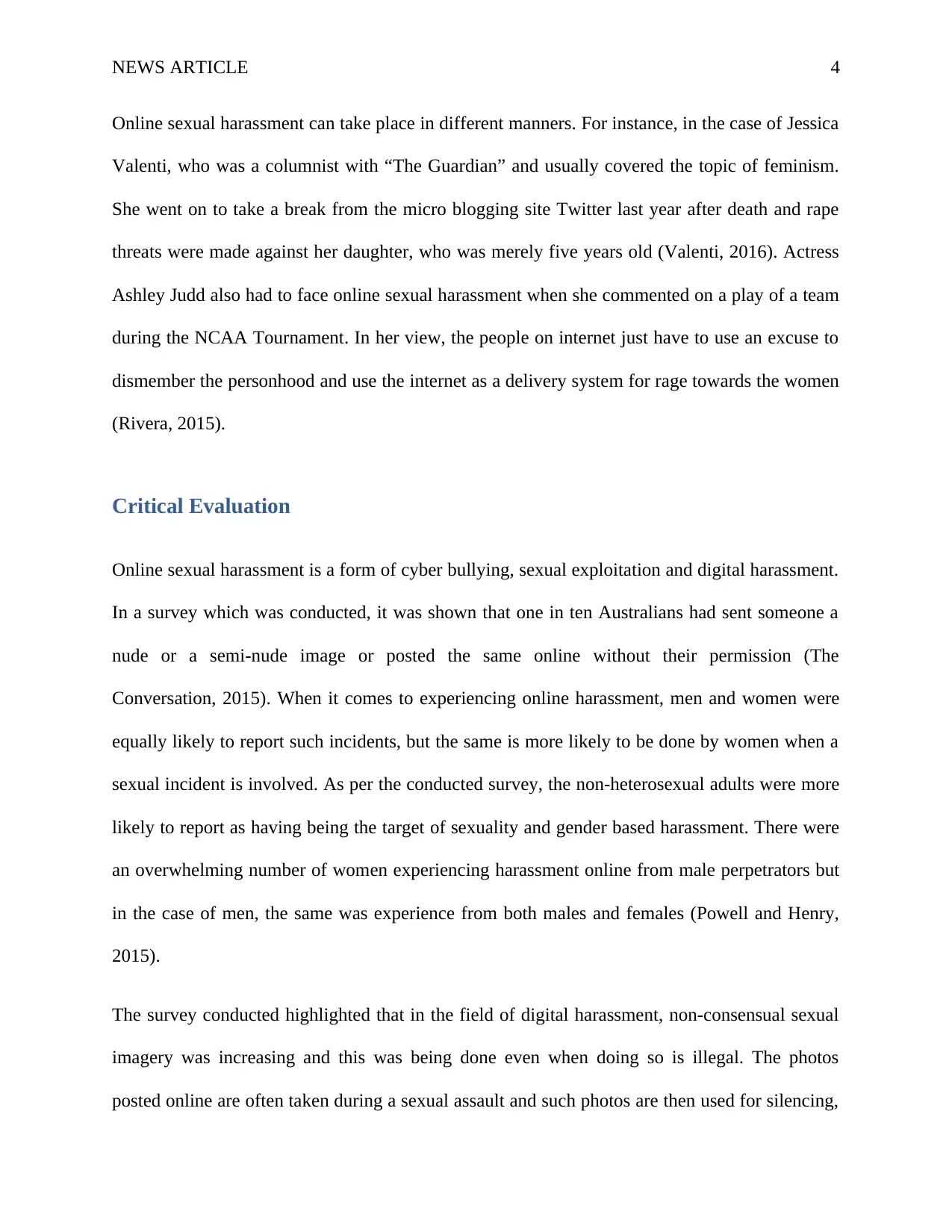
NEWS ARTICLE 4
Online sexual harassment can take place in different manners. For instance, in the case of Jessica
Valenti, who was a columnist with “The Guardian” and usually covered the topic of feminism.
She went on to take a break from the micro blogging site Twitter last year after death and rape
threats were made against her daughter, who was merely five years old (Valenti, 2016). Actress
Ashley Judd also had to face online sexual harassment when she commented on a play of a team
during the NCAA Tournament. In her view, the people on internet just have to use an excuse to
dismember the personhood and use the internet as a delivery system for rage towards the women
(Rivera, 2015).
Critical Evaluation
Online sexual harassment is a form of cyber bullying, sexual exploitation and digital harassment.
In a survey which was conducted, it was shown that one in ten Australians had sent someone a
nude or a semi-nude image or posted the same online without their permission (The
Conversation, 2015). When it comes to experiencing online harassment, men and women were
equally likely to report such incidents, but the same is more likely to be done by women when a
sexual incident is involved. As per the conducted survey, the non-heterosexual adults were more
likely to report as having being the target of sexuality and gender based harassment. There were
an overwhelming number of women experiencing harassment online from male perpetrators but
in the case of men, the same was experience from both males and females (Powell and Henry,
2015).
The survey conducted highlighted that in the field of digital harassment, non-consensual sexual
imagery was increasing and this was being done even when doing so is illegal. The photos
posted online are often taken during a sexual assault and such photos are then used for silencing,
Online sexual harassment can take place in different manners. For instance, in the case of Jessica
Valenti, who was a columnist with “The Guardian” and usually covered the topic of feminism.
She went on to take a break from the micro blogging site Twitter last year after death and rape
threats were made against her daughter, who was merely five years old (Valenti, 2016). Actress
Ashley Judd also had to face online sexual harassment when she commented on a play of a team
during the NCAA Tournament. In her view, the people on internet just have to use an excuse to
dismember the personhood and use the internet as a delivery system for rage towards the women
(Rivera, 2015).
Critical Evaluation
Online sexual harassment is a form of cyber bullying, sexual exploitation and digital harassment.
In a survey which was conducted, it was shown that one in ten Australians had sent someone a
nude or a semi-nude image or posted the same online without their permission (The
Conversation, 2015). When it comes to experiencing online harassment, men and women were
equally likely to report such incidents, but the same is more likely to be done by women when a
sexual incident is involved. As per the conducted survey, the non-heterosexual adults were more
likely to report as having being the target of sexuality and gender based harassment. There were
an overwhelming number of women experiencing harassment online from male perpetrators but
in the case of men, the same was experience from both males and females (Powell and Henry,
2015).
The survey conducted highlighted that in the field of digital harassment, non-consensual sexual
imagery was increasing and this was being done even when doing so is illegal. The photos
posted online are often taken during a sexual assault and such photos are then used for silencing,
Paraphrase This Document
Need a fresh take? Get an instant paraphrase of this document with our AI Paraphraser
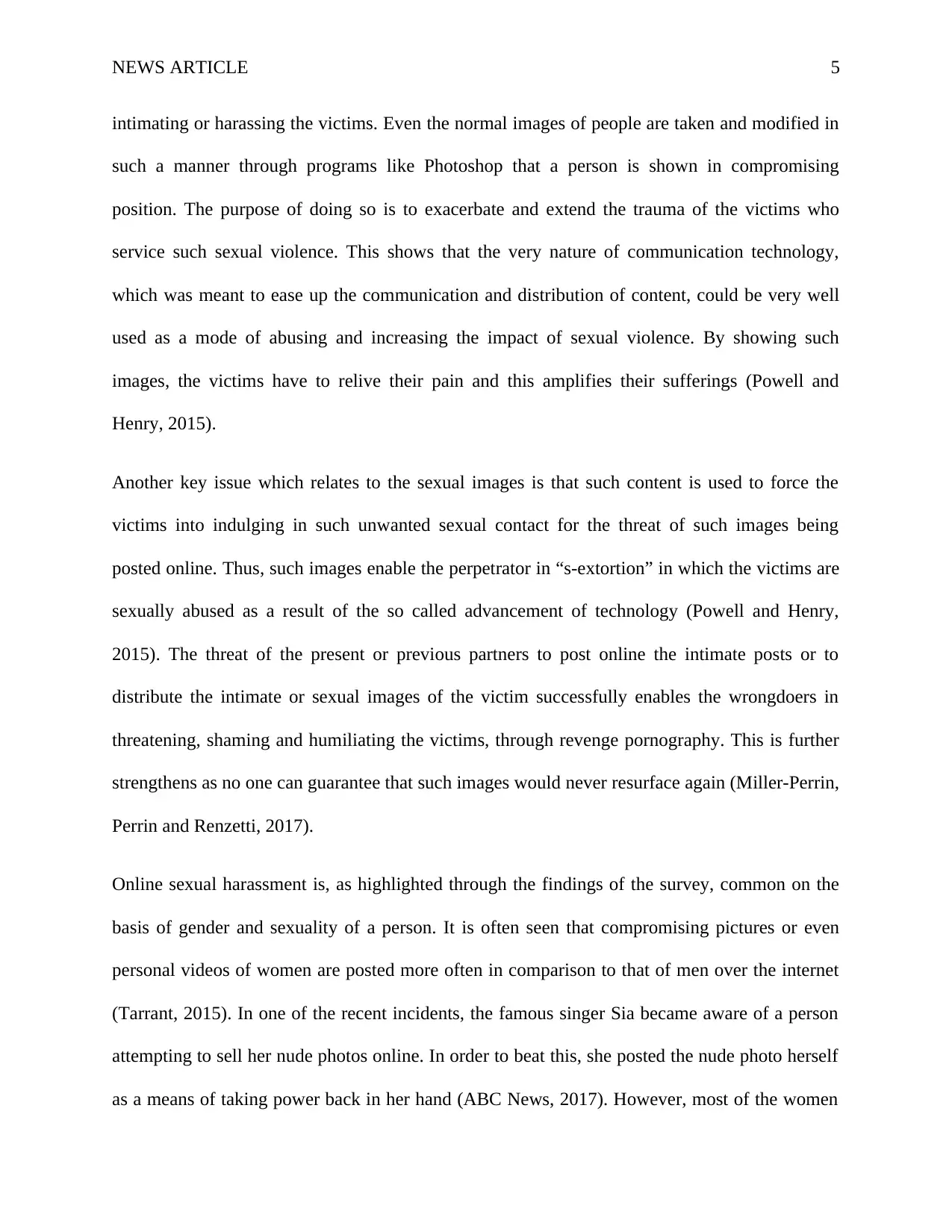
NEWS ARTICLE 5
intimating or harassing the victims. Even the normal images of people are taken and modified in
such a manner through programs like Photoshop that a person is shown in compromising
position. The purpose of doing so is to exacerbate and extend the trauma of the victims who
service such sexual violence. This shows that the very nature of communication technology,
which was meant to ease up the communication and distribution of content, could be very well
used as a mode of abusing and increasing the impact of sexual violence. By showing such
images, the victims have to relive their pain and this amplifies their sufferings (Powell and
Henry, 2015).
Another key issue which relates to the sexual images is that such content is used to force the
victims into indulging in such unwanted sexual contact for the threat of such images being
posted online. Thus, such images enable the perpetrator in “s-extortion” in which the victims are
sexually abused as a result of the so called advancement of technology (Powell and Henry,
2015). The threat of the present or previous partners to post online the intimate posts or to
distribute the intimate or sexual images of the victim successfully enables the wrongdoers in
threatening, shaming and humiliating the victims, through revenge pornography. This is further
strengthens as no one can guarantee that such images would never resurface again (Miller-Perrin,
Perrin and Renzetti, 2017).
Online sexual harassment is, as highlighted through the findings of the survey, common on the
basis of gender and sexuality of a person. It is often seen that compromising pictures or even
personal videos of women are posted more often in comparison to that of men over the internet
(Tarrant, 2015). In one of the recent incidents, the famous singer Sia became aware of a person
attempting to sell her nude photos online. In order to beat this, she posted the nude photo herself
as a means of taking power back in her hand (ABC News, 2017). However, most of the women
intimating or harassing the victims. Even the normal images of people are taken and modified in
such a manner through programs like Photoshop that a person is shown in compromising
position. The purpose of doing so is to exacerbate and extend the trauma of the victims who
service such sexual violence. This shows that the very nature of communication technology,
which was meant to ease up the communication and distribution of content, could be very well
used as a mode of abusing and increasing the impact of sexual violence. By showing such
images, the victims have to relive their pain and this amplifies their sufferings (Powell and
Henry, 2015).
Another key issue which relates to the sexual images is that such content is used to force the
victims into indulging in such unwanted sexual contact for the threat of such images being
posted online. Thus, such images enable the perpetrator in “s-extortion” in which the victims are
sexually abused as a result of the so called advancement of technology (Powell and Henry,
2015). The threat of the present or previous partners to post online the intimate posts or to
distribute the intimate or sexual images of the victim successfully enables the wrongdoers in
threatening, shaming and humiliating the victims, through revenge pornography. This is further
strengthens as no one can guarantee that such images would never resurface again (Miller-Perrin,
Perrin and Renzetti, 2017).
Online sexual harassment is, as highlighted through the findings of the survey, common on the
basis of gender and sexuality of a person. It is often seen that compromising pictures or even
personal videos of women are posted more often in comparison to that of men over the internet
(Tarrant, 2015). In one of the recent incidents, the famous singer Sia became aware of a person
attempting to sell her nude photos online. In order to beat this, she posted the nude photo herself
as a means of taking power back in her hand (ABC News, 2017). However, most of the women
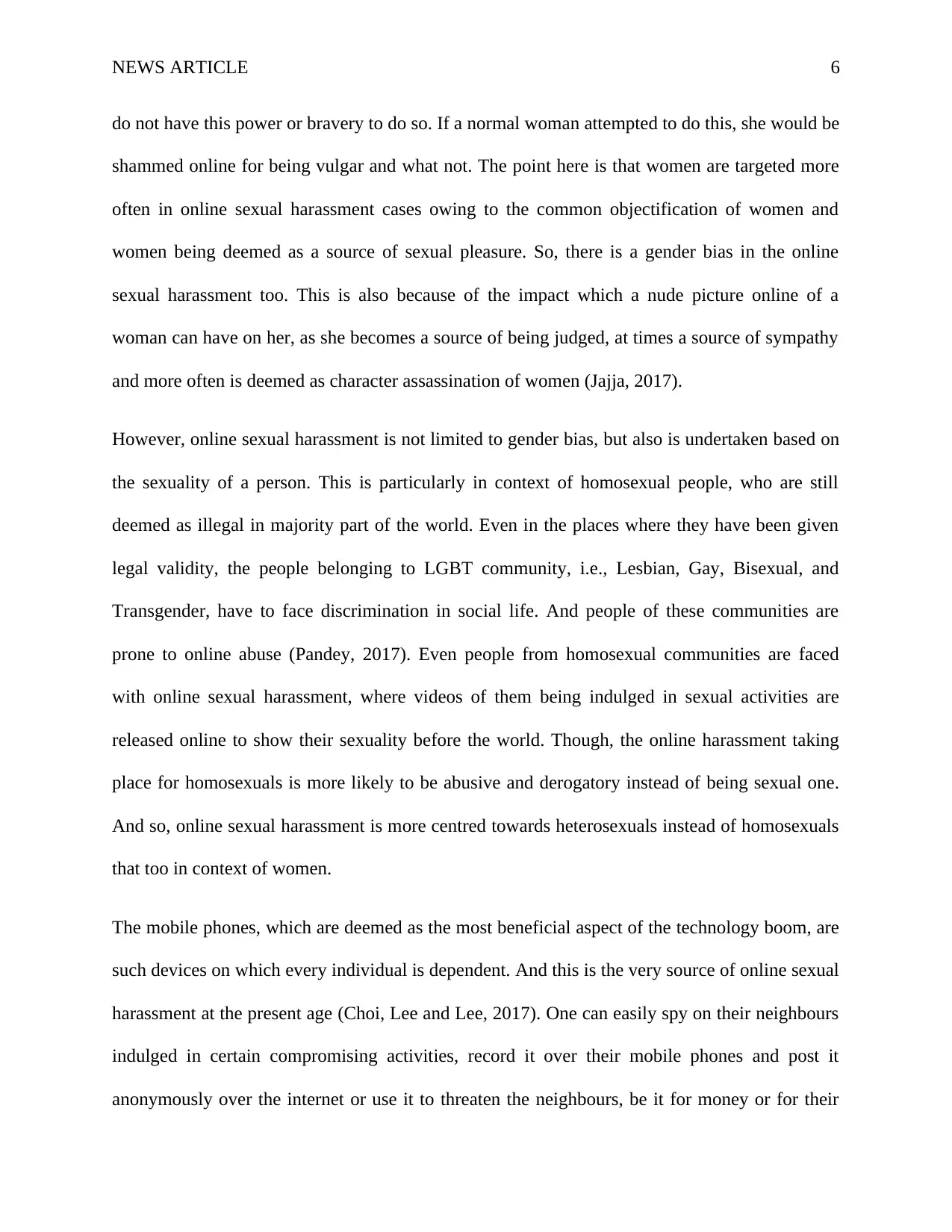
NEWS ARTICLE 6
do not have this power or bravery to do so. If a normal woman attempted to do this, she would be
shammed online for being vulgar and what not. The point here is that women are targeted more
often in online sexual harassment cases owing to the common objectification of women and
women being deemed as a source of sexual pleasure. So, there is a gender bias in the online
sexual harassment too. This is also because of the impact which a nude picture online of a
woman can have on her, as she becomes a source of being judged, at times a source of sympathy
and more often is deemed as character assassination of women (Jajja, 2017).
However, online sexual harassment is not limited to gender bias, but also is undertaken based on
the sexuality of a person. This is particularly in context of homosexual people, who are still
deemed as illegal in majority part of the world. Even in the places where they have been given
legal validity, the people belonging to LGBT community, i.e., Lesbian, Gay, Bisexual, and
Transgender, have to face discrimination in social life. And people of these communities are
prone to online abuse (Pandey, 2017). Even people from homosexual communities are faced
with online sexual harassment, where videos of them being indulged in sexual activities are
released online to show their sexuality before the world. Though, the online harassment taking
place for homosexuals is more likely to be abusive and derogatory instead of being sexual one.
And so, online sexual harassment is more centred towards heterosexuals instead of homosexuals
that too in context of women.
The mobile phones, which are deemed as the most beneficial aspect of the technology boom, are
such devices on which every individual is dependent. And this is the very source of online sexual
harassment at the present age (Choi, Lee and Lee, 2017). One can easily spy on their neighbours
indulged in certain compromising activities, record it over their mobile phones and post it
anonymously over the internet or use it to threaten the neighbours, be it for money or for their
do not have this power or bravery to do so. If a normal woman attempted to do this, she would be
shammed online for being vulgar and what not. The point here is that women are targeted more
often in online sexual harassment cases owing to the common objectification of women and
women being deemed as a source of sexual pleasure. So, there is a gender bias in the online
sexual harassment too. This is also because of the impact which a nude picture online of a
woman can have on her, as she becomes a source of being judged, at times a source of sympathy
and more often is deemed as character assassination of women (Jajja, 2017).
However, online sexual harassment is not limited to gender bias, but also is undertaken based on
the sexuality of a person. This is particularly in context of homosexual people, who are still
deemed as illegal in majority part of the world. Even in the places where they have been given
legal validity, the people belonging to LGBT community, i.e., Lesbian, Gay, Bisexual, and
Transgender, have to face discrimination in social life. And people of these communities are
prone to online abuse (Pandey, 2017). Even people from homosexual communities are faced
with online sexual harassment, where videos of them being indulged in sexual activities are
released online to show their sexuality before the world. Though, the online harassment taking
place for homosexuals is more likely to be abusive and derogatory instead of being sexual one.
And so, online sexual harassment is more centred towards heterosexuals instead of homosexuals
that too in context of women.
The mobile phones, which are deemed as the most beneficial aspect of the technology boom, are
such devices on which every individual is dependent. And this is the very source of online sexual
harassment at the present age (Choi, Lee and Lee, 2017). One can easily spy on their neighbours
indulged in certain compromising activities, record it over their mobile phones and post it
anonymously over the internet or use it to threaten the neighbours, be it for money or for their
⊘ This is a preview!⊘
Do you want full access?
Subscribe today to unlock all pages.

Trusted by 1+ million students worldwide
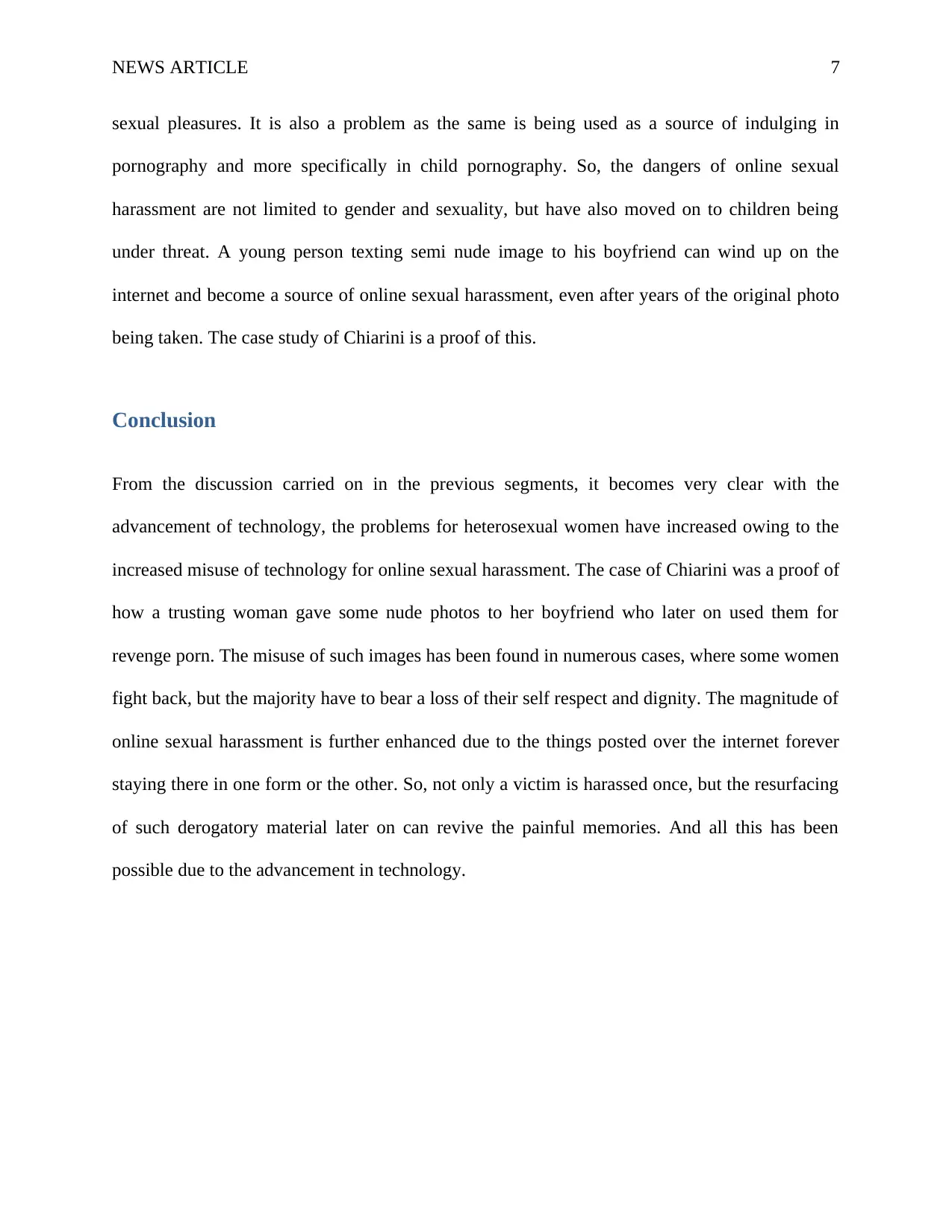
NEWS ARTICLE 7
sexual pleasures. It is also a problem as the same is being used as a source of indulging in
pornography and more specifically in child pornography. So, the dangers of online sexual
harassment are not limited to gender and sexuality, but have also moved on to children being
under threat. A young person texting semi nude image to his boyfriend can wind up on the
internet and become a source of online sexual harassment, even after years of the original photo
being taken. The case study of Chiarini is a proof of this.
Conclusion
From the discussion carried on in the previous segments, it becomes very clear with the
advancement of technology, the problems for heterosexual women have increased owing to the
increased misuse of technology for online sexual harassment. The case of Chiarini was a proof of
how a trusting woman gave some nude photos to her boyfriend who later on used them for
revenge porn. The misuse of such images has been found in numerous cases, where some women
fight back, but the majority have to bear a loss of their self respect and dignity. The magnitude of
online sexual harassment is further enhanced due to the things posted over the internet forever
staying there in one form or the other. So, not only a victim is harassed once, but the resurfacing
of such derogatory material later on can revive the painful memories. And all this has been
possible due to the advancement in technology.
sexual pleasures. It is also a problem as the same is being used as a source of indulging in
pornography and more specifically in child pornography. So, the dangers of online sexual
harassment are not limited to gender and sexuality, but have also moved on to children being
under threat. A young person texting semi nude image to his boyfriend can wind up on the
internet and become a source of online sexual harassment, even after years of the original photo
being taken. The case study of Chiarini is a proof of this.
Conclusion
From the discussion carried on in the previous segments, it becomes very clear with the
advancement of technology, the problems for heterosexual women have increased owing to the
increased misuse of technology for online sexual harassment. The case of Chiarini was a proof of
how a trusting woman gave some nude photos to her boyfriend who later on used them for
revenge porn. The misuse of such images has been found in numerous cases, where some women
fight back, but the majority have to bear a loss of their self respect and dignity. The magnitude of
online sexual harassment is further enhanced due to the things posted over the internet forever
staying there in one form or the other. So, not only a victim is harassed once, but the resurfacing
of such derogatory material later on can revive the painful memories. And all this has been
possible due to the advancement in technology.
Paraphrase This Document
Need a fresh take? Get an instant paraphrase of this document with our AI Paraphraser
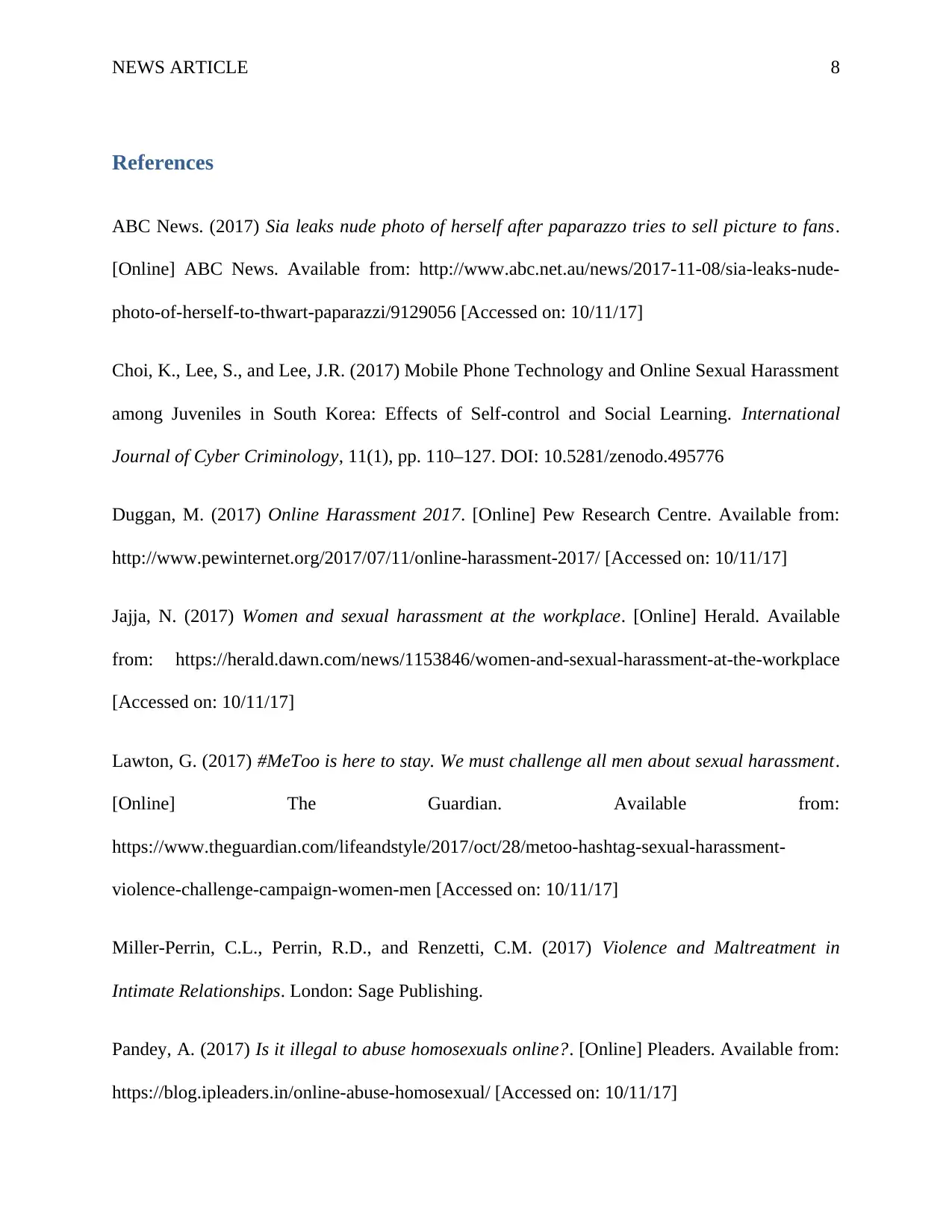
NEWS ARTICLE 8
References
ABC News. (2017) Sia leaks nude photo of herself after paparazzo tries to sell picture to fans.
[Online] ABC News. Available from: http://www.abc.net.au/news/2017-11-08/sia-leaks-nude-
photo-of-herself-to-thwart-paparazzi/9129056 [Accessed on: 10/11/17]
Choi, K., Lee, S., and Lee, J.R. (2017) Mobile Phone Technology and Online Sexual Harassment
among Juveniles in South Korea: Effects of Self-control and Social Learning. International
Journal of Cyber Criminology, 11(1), pp. 110–127. DOI: 10.5281/zenodo.495776
Duggan, M. (2017) Online Harassment 2017. [Online] Pew Research Centre. Available from:
http://www.pewinternet.org/2017/07/11/online-harassment-2017/ [Accessed on: 10/11/17]
Jajja, N. (2017) Women and sexual harassment at the workplace. [Online] Herald. Available
from: https://herald.dawn.com/news/1153846/women-and-sexual-harassment-at-the-workplace
[Accessed on: 10/11/17]
Lawton, G. (2017) #MeToo is here to stay. We must challenge all men about sexual harassment.
[Online] The Guardian. Available from:
https://www.theguardian.com/lifeandstyle/2017/oct/28/metoo-hashtag-sexual-harassment-
violence-challenge-campaign-women-men [Accessed on: 10/11/17]
Miller-Perrin, C.L., Perrin, R.D., and Renzetti, C.M. (2017) Violence and Maltreatment in
Intimate Relationships. London: Sage Publishing.
Pandey, A. (2017) Is it illegal to abuse homosexuals online?. [Online] Pleaders. Available from:
https://blog.ipleaders.in/online-abuse-homosexual/ [Accessed on: 10/11/17]
References
ABC News. (2017) Sia leaks nude photo of herself after paparazzo tries to sell picture to fans.
[Online] ABC News. Available from: http://www.abc.net.au/news/2017-11-08/sia-leaks-nude-
photo-of-herself-to-thwart-paparazzi/9129056 [Accessed on: 10/11/17]
Choi, K., Lee, S., and Lee, J.R. (2017) Mobile Phone Technology and Online Sexual Harassment
among Juveniles in South Korea: Effects of Self-control and Social Learning. International
Journal of Cyber Criminology, 11(1), pp. 110–127. DOI: 10.5281/zenodo.495776
Duggan, M. (2017) Online Harassment 2017. [Online] Pew Research Centre. Available from:
http://www.pewinternet.org/2017/07/11/online-harassment-2017/ [Accessed on: 10/11/17]
Jajja, N. (2017) Women and sexual harassment at the workplace. [Online] Herald. Available
from: https://herald.dawn.com/news/1153846/women-and-sexual-harassment-at-the-workplace
[Accessed on: 10/11/17]
Lawton, G. (2017) #MeToo is here to stay. We must challenge all men about sexual harassment.
[Online] The Guardian. Available from:
https://www.theguardian.com/lifeandstyle/2017/oct/28/metoo-hashtag-sexual-harassment-
violence-challenge-campaign-women-men [Accessed on: 10/11/17]
Miller-Perrin, C.L., Perrin, R.D., and Renzetti, C.M. (2017) Violence and Maltreatment in
Intimate Relationships. London: Sage Publishing.
Pandey, A. (2017) Is it illegal to abuse homosexuals online?. [Online] Pleaders. Available from:
https://blog.ipleaders.in/online-abuse-homosexual/ [Accessed on: 10/11/17]
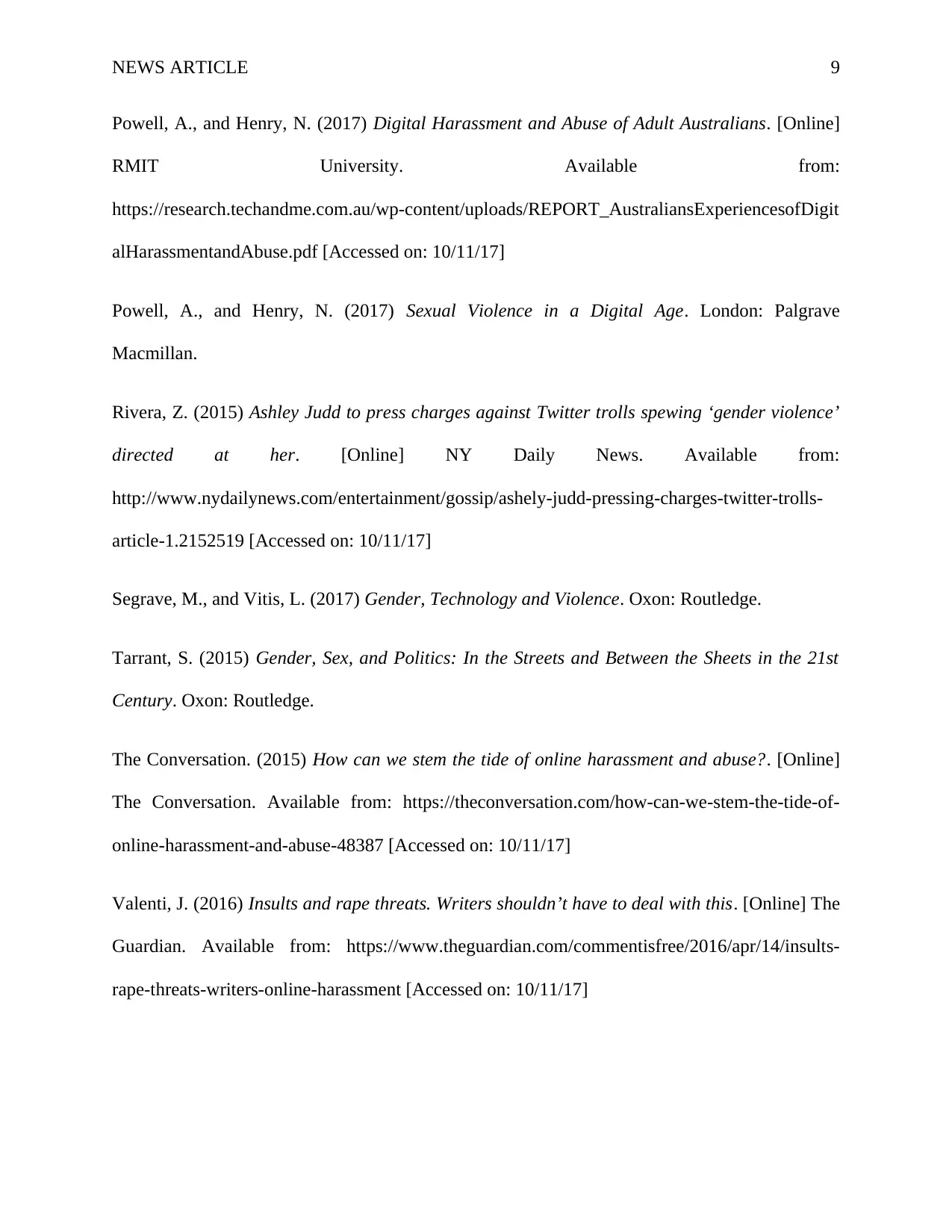
NEWS ARTICLE 9
Powell, A., and Henry, N. (2017) Digital Harassment and Abuse of Adult Australians. [Online]
RMIT University. Available from:
https://research.techandme.com.au/wp-content/uploads/REPORT_AustraliansExperiencesofDigit
alHarassmentandAbuse.pdf [Accessed on: 10/11/17]
Powell, A., and Henry, N. (2017) Sexual Violence in a Digital Age. London: Palgrave
Macmillan.
Rivera, Z. (2015) Ashley Judd to press charges against Twitter trolls spewing ‘gender violence’
directed at her. [Online] NY Daily News. Available from:
http://www.nydailynews.com/entertainment/gossip/ashely-judd-pressing-charges-twitter-trolls-
article-1.2152519 [Accessed on: 10/11/17]
Segrave, M., and Vitis, L. (2017) Gender, Technology and Violence. Oxon: Routledge.
Tarrant, S. (2015) Gender, Sex, and Politics: In the Streets and Between the Sheets in the 21st
Century. Oxon: Routledge.
The Conversation. (2015) How can we stem the tide of online harassment and abuse?. [Online]
The Conversation. Available from: https://theconversation.com/how-can-we-stem-the-tide-of-
online-harassment-and-abuse-48387 [Accessed on: 10/11/17]
Valenti, J. (2016) Insults and rape threats. Writers shouldn’t have to deal with this. [Online] The
Guardian. Available from: https://www.theguardian.com/commentisfree/2016/apr/14/insults-
rape-threats-writers-online-harassment [Accessed on: 10/11/17]
Powell, A., and Henry, N. (2017) Digital Harassment and Abuse of Adult Australians. [Online]
RMIT University. Available from:
https://research.techandme.com.au/wp-content/uploads/REPORT_AustraliansExperiencesofDigit
alHarassmentandAbuse.pdf [Accessed on: 10/11/17]
Powell, A., and Henry, N. (2017) Sexual Violence in a Digital Age. London: Palgrave
Macmillan.
Rivera, Z. (2015) Ashley Judd to press charges against Twitter trolls spewing ‘gender violence’
directed at her. [Online] NY Daily News. Available from:
http://www.nydailynews.com/entertainment/gossip/ashely-judd-pressing-charges-twitter-trolls-
article-1.2152519 [Accessed on: 10/11/17]
Segrave, M., and Vitis, L. (2017) Gender, Technology and Violence. Oxon: Routledge.
Tarrant, S. (2015) Gender, Sex, and Politics: In the Streets and Between the Sheets in the 21st
Century. Oxon: Routledge.
The Conversation. (2015) How can we stem the tide of online harassment and abuse?. [Online]
The Conversation. Available from: https://theconversation.com/how-can-we-stem-the-tide-of-
online-harassment-and-abuse-48387 [Accessed on: 10/11/17]
Valenti, J. (2016) Insults and rape threats. Writers shouldn’t have to deal with this. [Online] The
Guardian. Available from: https://www.theguardian.com/commentisfree/2016/apr/14/insults-
rape-threats-writers-online-harassment [Accessed on: 10/11/17]
⊘ This is a preview!⊘
Do you want full access?
Subscribe today to unlock all pages.

Trusted by 1+ million students worldwide

NEWS ARTICLE 10
Wallace, K. (2017) After Weinstein, don't forget about online sexual harassment. [Online] CNN.
Available from: http://edition.cnn.com/2017/10/26/health/harvey-weinstein-online-sexual-
harassment/index.html [Accessed on: 10/11/17]
Wallace, K. (2017) After Weinstein, don't forget about online sexual harassment. [Online] CNN.
Available from: http://edition.cnn.com/2017/10/26/health/harvey-weinstein-online-sexual-
harassment/index.html [Accessed on: 10/11/17]
1 out of 10
Related Documents
Your All-in-One AI-Powered Toolkit for Academic Success.
+13062052269
info@desklib.com
Available 24*7 on WhatsApp / Email
![[object Object]](/_next/static/media/star-bottom.7253800d.svg)
Unlock your academic potential
Copyright © 2020–2025 A2Z Services. All Rights Reserved. Developed and managed by ZUCOL.





